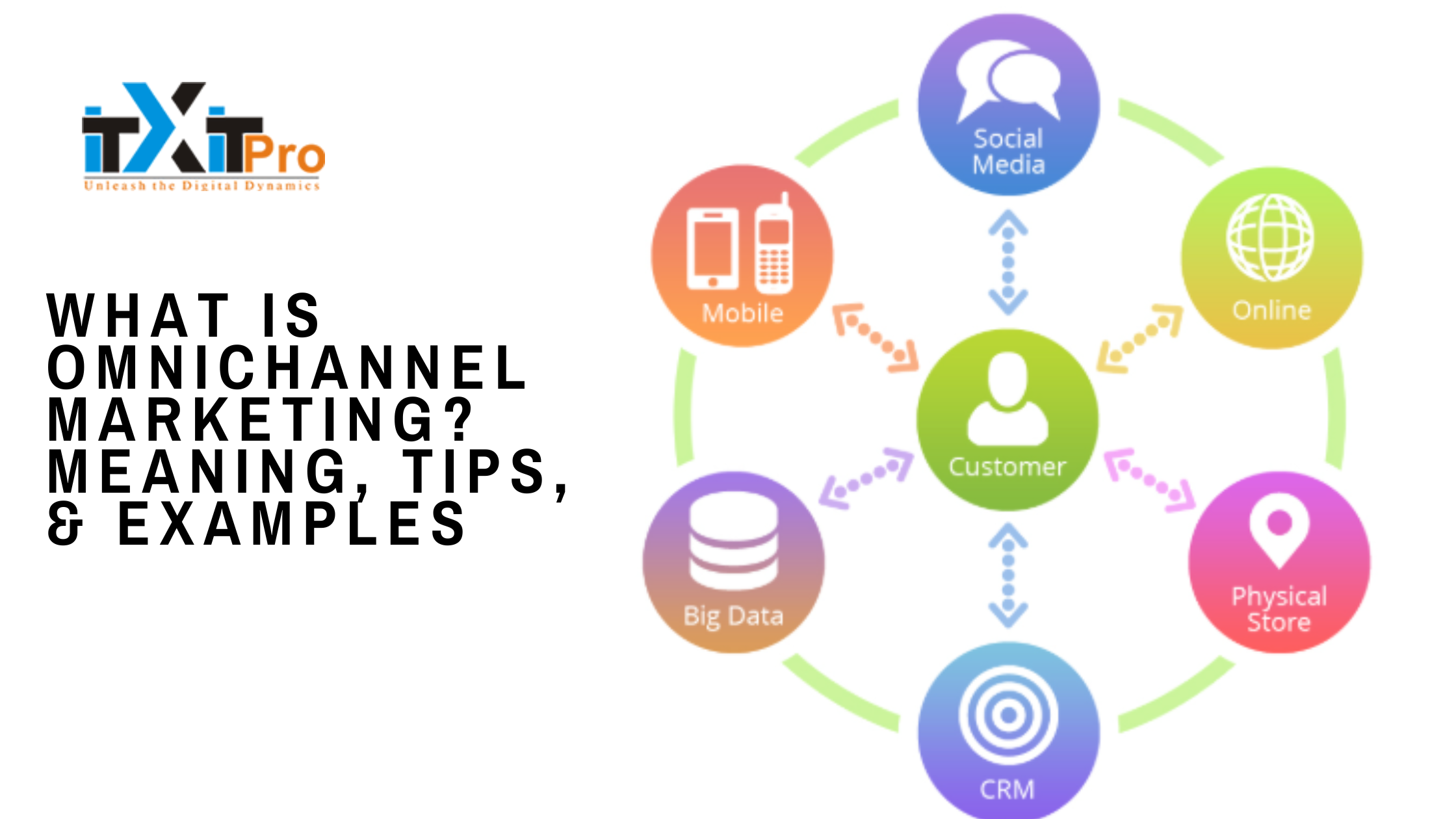Introduction

In today’s fast-paced digital environment, companies are always searching for ways to distinguish themselves and maintain a connection with their consumers. The most effective opportunity to do this is with the strategy of omnichannel marketing. Omnichannel marketing is different from other traditional forms of marketing, which focus on the usage of one or two channels, because it uses the whole spectrum of channels seamlessly and uniquely, which enhances the customer experience.
In this blog, we will consider what omnichannel marketing is, how it is different from multichannel marketing, the significant benefits of omnichannel marketing, and the key steps to implement a successful omnichannel marketing process to encourage better customer engagement, better brand loyalty, and increased sales.
What is Omnichannel Marketing?
Essentially, omnichannel marketing is about creating a cohesive customer experience across all channels and touchpoints. Whether a customer is browsing your website, shopping on social media, engaging with an email campaign, or stopping into your store to shop, omnichannel marketing connects all of these channels and allows them to work together flawlessly.
As opposed to multichannel marketing, where each channel is seen as its own entity and offers potentially differing messages, omnichannel marketing connects these channels as one to create a consistent brand experience. The purpose is to meet the customer where they are, show them their path, and provide a seamless experience along the way. Regardless of the touchpoint, the customer should know they are getting the same personalised service and message.
Omnichannel vs. Multichannel Marketing
Before getting into the details of how omnichannel works, it is necessary to explore the idea of omnichannel marketing to understand the key difference from multichannel marketing.
Multichannel Marketing:
This is the act of putting promotional messages into multiple communication channels to reach your audience—social media, email, physical stores, websites, etc. Multichannel marketing typically means that the channels do not interrelate and function independently of each other. So, for example, you might send a promotional email to a customer, have a social ad running on some media, and also advertise in a brick-and-mortar store, but there is no journey for the customer back to the brand. Each promotional piece is working in isolation.
Omnichannel Marketing:
This relates to interrelation and connects all of the marketing “channels” into one experience. All the touchpoints that a customer has will work together to provide a unified experience. If a customer sees an ad on Instagram, clicks into the brand’s website, and later receives an email about the sale, all marketing has a continuity of brand message and tone. The experience is not fragmented but follows the customer wherever they go on their own experience.
Why Is Omnichannel Marketing Important?
Why Is Omnichannel Marketing Important? There are countless benefits to implementing an omnichannel model for customers and businesses alike. Below are some of the most significant benefits:
- Improved Customer Experience
An integrated, consistent experience allows customers to engage with your brand no matter the channel. Whether they are browsing through their mobile phone or shopping in-store, they receive the same messaging and service. Providing such excellent, individualised, and consistent experiences will enhance customer relationships, making them feel understood and valued at every touchpoint.
- Improved Customer Engagement
Customers are more likely to engage with content, promotions, and offers when they interact with a brand across multiple channels. Omnichannel marketing simply ensures that no matter where a customer begins their journey, they are prompted to influence the brand. It will ensure that they stay continuously engaged, and providing a personalised and continuous engagement will keep your business top-of-mind for guests and customers.
- Improved Conversion Rates
Omnichannel marketing improves conversion rates by smoothing the customer journey and decreasing friction at each step of the journey. Customers can seamlessly move between devices and channels without losing track of where they are in the sales funnel. For instance, a customer may browse products on your app, add items to their cart, and later receive an email reminder to complete the purchase. - Higher Customer Loyalty
A personalised, integrated experience develops loyalty. Customers will be more willing to engage with a brand that knows their needs and offers a continuous, agreeable experience across all touchpoints. When customers experience value consistently from your omnichannel efforts, you develop a long-term relationship, resulting in increased retention.
- Improved Data Insights
Omnichannel marketing creates a staggering amount of data across all touchpoints for the organisation to review to understand customer behaviour and preferences more deeply. This data can be leveraged by the organisation to analyse and maximise future campaigns, personalise offers, and improve marketing outcomes.
Tips for Implementing an Omnichannel Marketing Strategy
Executing an effective omnichannel marketing plan will take a little planning, some integration, and some execution. Below is a step-by-step process you can use to implement an effective omnichannel marketing plan.
- Learn About Your Audience
First, a major component towards building any successful marketing plan is understanding your audience. To build a successful omnichannel marketing plan, it is essential you understand the preferences, behaviours, and pain points of your customers. Would your customers be more inclined to engage with your brand on social media? Would they think email promotions to the store were better than an in-store deal? Understanding “when” and “how” the audience engages with your brand will help you create a seamless experience for them.
- Select Your Channels
After gaining insight into your audience, you then need to select the right channels to effectively reach them. While your channels may consist solely of digital marketing (social media, email, website, and/or other interactive platforms), your channels may also include physical touchpoints (stores, community events, pop-ups, etc.). Just ensure the channels are aligned to your audience’s habits and now integrated into one overall strategy.
- Ensure Consistent Messaging
Across all channels. One of the keys to effective omnichannel marketing is consistency. The messaging you use on your website, social media, emails, and physical stores should be consistent with your brand voice and messaging. You don’t have to use the same message on every channel, but they should all be consistent in values, tone, and goals. Consistency develops trust and recognition with customers and assures customers know what to expect from your brand.
- Use Technology to Integrate Channel
Technology is key to the performance of omnichannel marketing. Use technology to help unify your marketing across channels. A customer relationship management (CRM) system will help you track customer engagement across channels, while employing email automation and social media tools will help the communications run more smoothly.
- Customize the Customer Experience
Customisation is one of the key elements of omnichannel marketing. Utilising data and insights to personalise the customer journey is quite effective in creating a more meaningful experience. In other words, personalised emails, product recommendations based on browsing behaviour, and even targeted ads based on your customers’ location can help create a seamless experience.
- Assess Performance and Improve
Once you implement your omnichannel marketing strategy, it’s important to continuously measure performance. Use analytics software to track metrics like conversion rates, engagement, and customer retention rates across all channels. This data will inform modifications, help align messaging, and improve the customer experience.
Examples of Omnichannel Marketing Campaign Success Stories
-
Sephora
Sephora, a leader in the global cosmetics business, excels at omnichannel marketing because it integrates its online and offline experiences so neatly. Customers can find products on the site, check inventory in nearby locations, and even use the Sephora app to try on makeup. Their loyalty program is also connected across all channels; customers can earn rewards online or in-store while benefiting from personalised rewards along the way.
-
Starbucks
Starbucks has also perfected the omnichannel experience; customers can order and pay for their drinks through the mobile app, earn loyalty rewards, and simply pick up their coffee in-store or have it delivered. Starbucks’s app experience perfectly integrates your experience in the store, offering promotions, loyalty rewards, and personalized offers based on purchasing history.
-
NikeNike
excels at creating an omnichannel experience for its customers. Customers can shop online, in-store, or through the Nike app. Nike includes personalized experiences into its customer experience by offering customers curated offers and curated product recommendations based on the customer’s purchase history via a membership program. Returns and exchanges are easy whether the customer made their purchase in-store or online, allowing for a smooth experience whether, for example, you took home your “regular dose of heel heel” t-shirt but it does not fit after picking it up in store as well.
Conclusion
Omnichannel marketing is no longer just a buzzword; it’s a strategy that every business must employ to provide an integrated, personalised, and seamless customer experience. Organisations can provide higher-level experiences to customers through the use of multiple channels in a way that connects with customers. You will deepen customer relationships, increase engagement, and drive conversions. If you are ready to add “omnichannel” to your task list, start using omnichannel marketing as part of your strategy today. If you have the right tools, insights, and consistency, your brand can be well on its way to providing a customer experience that drives loyalty and wins.















